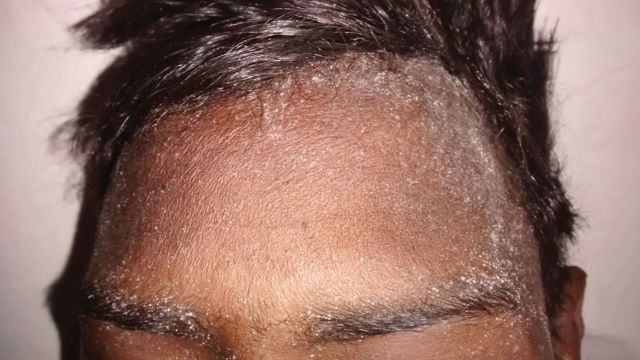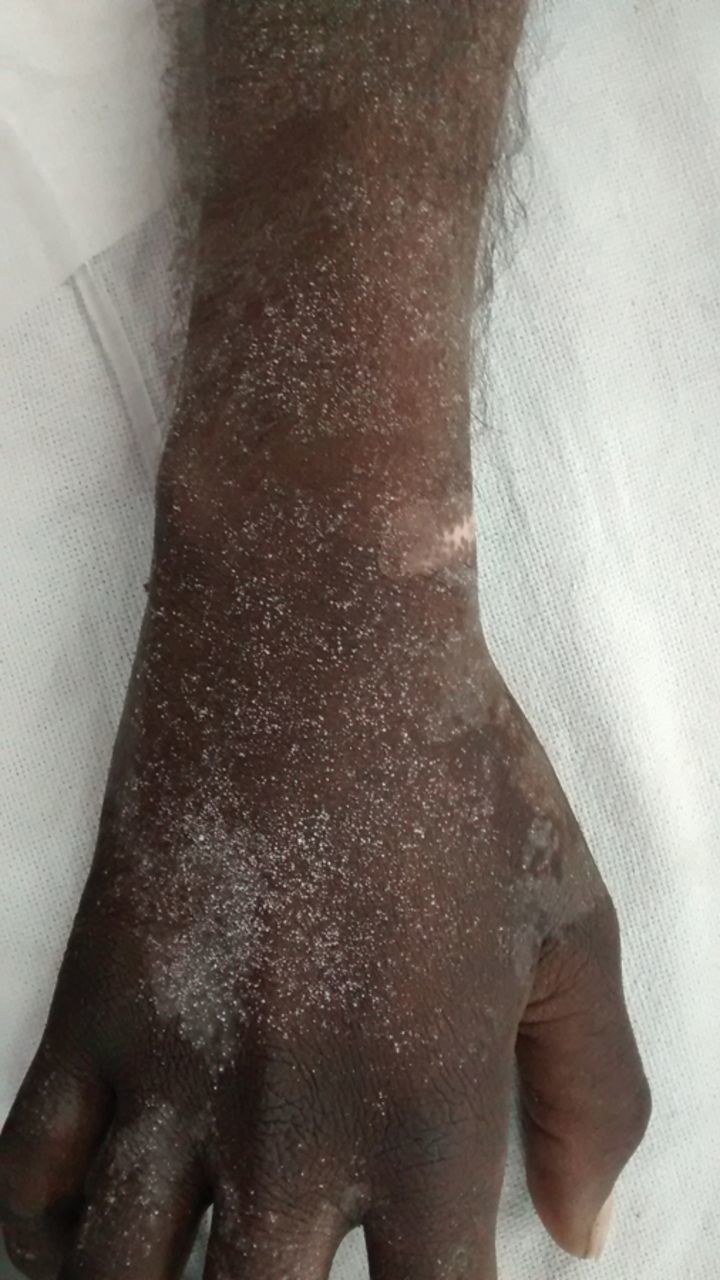Full blown uremic syndrome of chronic kidney disease (CKD) is seldom seen these days due to early initiation of renal replacement therapies (RRT) [1, 2]. Uremic frost is a manifestation of advanced CKD but rarely seen due to effective RRT.
We came across a 21-year-old male patient, brought to us with complaints of nausea, anorexia, oliguria and recent onset alteration in sensorium. On physical examination he had uremic fetor, pericardial rub and the most striking physical finding was whitish powdery frost, which was present all over his body, especially over the face and limbs (Figures 1–3). His laboratory investigations showed a serum creatinine of 1635.4 µmol/L (18.5 mg/dL) and blood urea nitrogen (BUN) of 79.59 mmol/L (218 mg/dL). His arterial blood gases were consistent with high anion metabolic acidosis.
Fig. 2.

Uremic frost on the forehead.
Fig. 1.

Uremic frost over the face.
Fig. 3.

Uremic frost on the upper limb.
To verify that the crystals were composed of urea or nitrogenous waste, we took scrapings of the frost and diluted it in normal saline, this was tested for urea levels, which was found to be comparable with serum urea levels.
He was immediately initiated on hemodialysis and there was gradual improvement in his sensorium and other symptoms over the next 4–5 days.
Uremic frost was first described by Hirschsprung in 1865 [3] and, as already mentioned, is seen very rarely today. A study by Udaykumar et al. [4] on dermatological changes in CKD showed the incidence of uremic frost to be 3%. When the BUN level is high, the concentration of urea in sweat increases greatly. Evaporation of sweat with high urea concentration causes urea to crystallize and deposit on the skin. The frost consists of a white or yellowish coating of urea crystals on the beard area and other parts of the face, neck and on the trunk [1, 2]. It is due to eccrine deposition of urea crystals on the skin surface of patients with severe uremia. As a cutaneous manifestation, uremic frost should be differentiated from retention keratosis, eczema and post-inflammatory desquamation [1]. However, a history of end-stage renal disease and the white, friable, crystalline characteristics of uremic frost can make its diagnosis easy.
Conflict of interest statement
None declared.
References
- 1.Kuo CC, Hung JB, Tsai CW, et al. Uremic frost. CMAJ. 2010;182:E800. doi: 10.1503/cmaj.091779. [DOI] [PMC free article] [PubMed] [Google Scholar]
- 2.Udayakumar P, Balasubramanian S, Ramalingam KS. Cutaneous manifestations in patients with chronic renal failure on hemodialysis. Indian J Dermatol Venereol Leprol. 2006;72:119–125. doi: 10.4103/0378-6323.25636. [DOI] [PubMed] [Google Scholar]
- 3.Pol-Rodriguez MM, Wanner M, Bhat P. Uremic frost in a critically ill patient. Kidney Int. 2008;73:790. doi: 10.1038/sj.ki.5002587. [DOI] [PubMed] [Google Scholar]
- 4.Walsh SR, Parada NA. Uremic frost. N Engl J Med. 2005;352:e13. doi: 10.1056/NEJMicm030792. [DOI] [PubMed] [Google Scholar]


